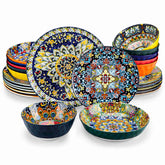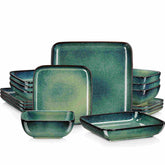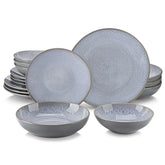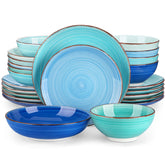From Design to Dinner: The Process of Making Dinnerware Sets
Navigation
- Inspiration and Design
- Production Process of Ceramic Dinnerware
- Quality Control and Packaging
- Sustainability in Dinnerware Production
Dinnerware sets are not only tableware but art pieces that enhance the dining experience and reflect cultural, aesthetic, and functional values. The purpose of this article is to give a general overview of how dinnerware sets are made, from the concept and drawing to production and even the process of putting the dinnerware sets in a box.
Inspiration and Design
Design Concepts
The process of designing dinnerware begins with ideas that are obtained from various regions. Designers employ nature, culture and fashion trends to create beautiful and elegant pieces. For example:
- Nature: Floral designs, earth tones, and geometric shapes that mimic leaves, water, or the sky.
- Cultural Traditions: For instance, the complex pattern of paisley from Indian art or the plain lines from Scandinavian design.
- Modern Trends: Saturated and contrasting colors and shapes that are inherent in modern dinnerware trends.
These inspirations are then brought out in design sketches where every line and curve is drawn with the view of attaining beauty and functionality. For instance, contemporary minimalist dinnerware is geometrically shaped and has monochromatic coloration, while boho chic dinnerware has bright colors and irregular shapes.
Material Selection
The material used defines the strength, appearance and functionality of dinnerware. Here's a closer look at some common materials:
- Stoneware: It is long-lasting and can be used for any occasion. It gives a more conventional appearance and feel and is excellent at insulating and retaining heat.
- Porcelain: Porcelain is fine-looking and very durable, which makes it suitable for more formal events.
Functional Design
Sturdiness is the most important factor that should be considered when designing dinnerware. Ergonomics, weight distribution and usage patterns are considered by designers to arrive at friendly designs. Key aspects include:
- Plate Depth: Helps to avoid spilling sauces and gravies over the clothes.
- Cup Grip: Grips that are comfortable to hold and also protect against heat.
- Cutlery Curves: Designed to be used in a way that is convenient.
Production Process of Ceramic Dinnerware
Material Selection
The process of manufacturing ceramic dinnerware starts with the choice of the right type of clay. Some of the most frequently used materials are porcelain, stoneware, and earthenware. These materials are procured from specific locations where they are known to be pure and then purified to remove any impurities. Porcelain is used for fine dining because of its transparency and hardness, while earthenware is used for casual dining because of its roughness.
Forming
After the clay has been prepared, it is molded into dinnerware products through different forming methods. These include:
- Hand-Throwing: The artisans then use a potter's wheel to mold the clay and create designs that are not mass-produced.
- Slip Casting: Slip, which is a liquid clay, is used to be poured into molds, which is perfect for making delicate shapes and sizes.
- Pressing: Clay is forced into molds at high pressure, ideal for large scale production.
Every technique adds certain features to the final product, which is why there is such a wide variety of ceramic dinnerware.
Bisque Firing
The formed clay items are dried to eliminate moisture before going through bisque firing. The first firing process is done at a relatively low temperature of between 1800 and 2000 degrees Fahrenheit and this process bakes the clay and makes it ready for glazing. At this stage, the pieces are relatively soft and can easily take on the glazes that are to be applied to them.
Glazing
Ceramic dinnerware is decorated with glazing to enhance its functionality and the aesthetics of the dinnerware. Glaze, which is a mixture of minerals and pigments, is then applied to the bisque-fired items. Glazing methods include:
- Dipping: Coating the items with a glaze mixture to make sure that it coats the items properly.
- Spraying: Spraying glaze using a spray gun so that the glaze is applied in the right areas and in the right way.
- Hand-Painting: Applying other patterns and engravings manually, which is typical for many artworks.
Decoration is not only responsible for the appearance of the dinnerware but also makes it water-resistant and non-porous.
Glaze Firing
The glazed pieces are then fired at higher temperatures, which vary between 2,100°F and 2,300°F, for the second time. This process bonds the clay and hardens the glaze to make the dinnerware more rigid, harder and provides a better surface finish. The final result is a smooth, glass-like surface that is not only functional but also looks good.
Decorative Techniques
Ceramic dinnerware often features decorative elements that elevate its aesthetic appeal:
- Blue and White Patterns: These patterns are traditional and, can be applied to any environment, and are inspired by Chinese ceramics.
- Kiln Firing Effects: The patterns that are created are random and not similar to each other, which gives the pieces character.
- Hand-Painting: Geometric designs and other intricate designs are employed to show that the work of the artisan is unique.
Quality Control and Packaging
Quality Inspection
This is done to ensure that only quality products are produced and delivered to the consumers in the market. Items are inspected for:
- Appearance: Uniformity of color, texture, and gloss.
- Size and Shape: Proportions that are accurate and conform to the design specifications.
- Material Integrity: Strength tests, endurance tests, and safety tests.
Packaging Design
The packaging is very important in preserving and marketing dinnerware. Modern packaging solutions focus on:
- Protection: Employment of shock absorbers to avoid breakages during transportation.
- Brand Image: Using sustainable materials and appealing designs that make the unboxing process more exciting.
Sustainability in Dinnerware Production
Sustainability has become a significant value in the dinnerware industry due to increasing consumer awareness and the fight against environmental issues. Therefore, there is a shift in the manufacturing processes to ensure that they incorporate environmentally friendly practices while at the same time maintaining the quality and appearance of the products. This shift is changing the way dinnerware is produced, and it is a clear sign of a focus on innovation and responsibility.
Optimized Production
Sustainable dinnerware production is not limited to the type of material used but also the process of making the dinnerware. Modern technologies and effective approaches are being used to increase productivity and minimize losses. For instance, are the heat produced by kilns, and water used in production lines is now being recycled by most manufacturing companies. These measures not only help in saving resources but also reduce operational expenses, which clearly indicates that sustainability and profitability are not mutually exclusive.
Energy efficient equipment and renewable power sources are also becoming popular. More and more factories are using solar power and LED lighting to reduce carbon emissions and make brands carbon neutral or even carbon positive. Also, efforts to obtain raw materials locally are also cutting down on emissions from transportation, which is also enhancing green production.
Dinnerware manufacturing is a perfect combination of art, technology, and innovation with a rising focus on sustainability. Starting with the choice of materials and ending with the choice of packaging, each stage is designed to minimize the company's carbon footprint and produce aesthetically pleasing and useful items.
Dinnerware sets can be made from porcelain, stoneware or biodegradable materials, and it is much more than just a tool; it is a symbol of the work and the commitment of the manufacturers. The next time you sit down to eat, spare a thought for the creativity that goes into your dinnerware and the sustainable processes that go into making it. Consumers can help create a more sustainable future by choosing products from sustainable brands, even if it is just for table settings.













